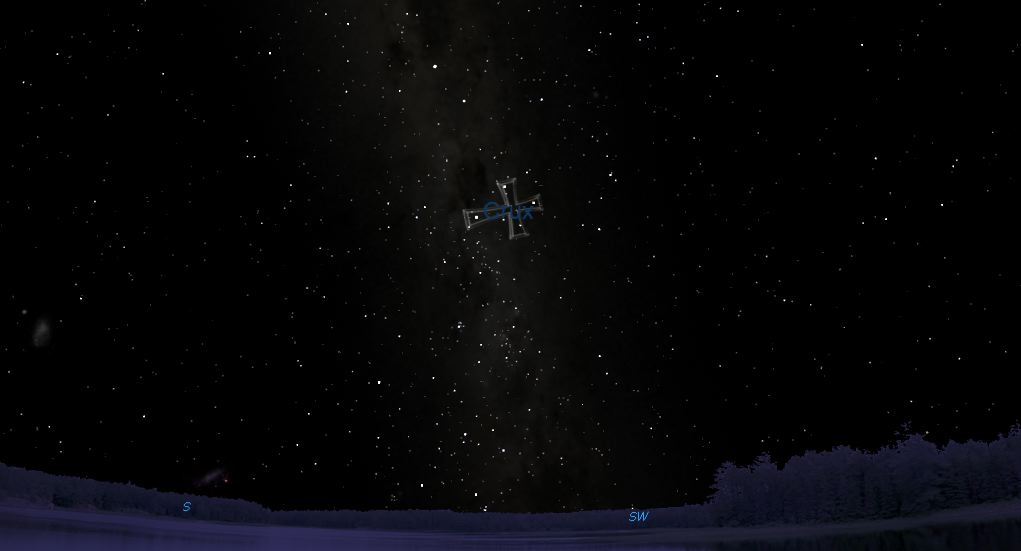Olympic Views: The Night Sky from Rio

From now through Aug. 21, the eyes of the world are on Rio de Janeiro, Brazil and the Games of the XXXI Olympiad. Recently, it crossed my mind that perhaps some of the competing athletes might have a passing interest in astronomy. If their homeland is from a location north of the equator, the sky above might appear a bit strange. Rio after all, is situated 22.9 degrees south of the equator.
If you were a discus thrower living in Athens, Greece, where the latitude is 38 degrees north, Polaris (the North Star) appears 38 degrees or almost halfway up from the northern horizon to the point overhead, called the zenith. As you travel south, Polaris approaches the horizon at the rate of about 1 degree, which is twice the apparent width of the full moon, for every 70 miles you go. Consequently, the north pole of the sky moves down — and the south pole of the sky moves up.
Some stars and constellations familiar to northerners begin to appear progressively lower, while new stars and constellations not available to those visible from northern latitudes begin to appear above the southern horizon. [See Summer Olympics Cities from Space (Satellite Photos)]
When you reach the equator, the north and south poles of the sky sit directly on their respective horizons and the Earth's daily rotation brings all the constellations above the horizon.
Continuing to move south of the equator, some of the constellations northerners are accustomed to seeing are barely visible or not at all. And everything in the sky gradually becomes inverted, at least from a northerner's perspective. From Rio, for example, right after sunset, the familiar Big Dipper is barely visible above the northwest horizon: only the end of its handle is in view, and appears upside down. If an athlete decided to arise at 3 a.m. and looked toward the northern horizon, he or she would see the bright zigzag row of five stars marking the "M" of Cassiopeia just scraping the northern horizon. Back home it might appear nearly overhead.
Also at that very early hour, about halfway up in the south, are two large patches of light — the satellite galaxies of our Milky Way, known as the Clouds of Magellan. Fifteenth and 16th century voyagers into the Southern Hemisphere brought back reports of these mysterious "whyte cloudes," which seemed like detached pieces of the Milky Way. Ferdinand Magellan was the first explorer to describe them to the Western world, and in his honor they are so named.
And a bonus: the center of our beautiful Milky Way galaxy appears almost directly overhead from Rio at around 9 p.m. local time, surrounded by the beautiful stars of Scorpius, the Scorpion and Sagittarius, which for many better resembles a teapot than an archer. And the planets Mars and Saturn, which are currently passing through this part of the sky, also appear virtually overhead. Low in the southwest, we could see Alpha Centauri, nearest of all the naked-eye stars, and its companion, Beta Centauri. Next to these southern twinklers, we can see the famous Southern Cross, the constellation Crux, which also occupies a place on the Brazilian flag.
Get the Space.com Newsletter
Breaking space news, the latest updates on rocket launches, skywatching events and more!
Of course, many of these sights would best be seen far from the outskirts of the city; like so many large metropolitan areas of the world, Rio's dazzling bright lights make it a heavily light-polluted city.
Those who take careful note of the sky might also sense something strange about the daytime. From northern latitudes, the sun appears to rise in the east, peaks at its highest altitude at midday over in the south and then sets in the west. It thus appears to travel across the sky from left to right.
But from Rio, the sun peaks at its highest point in the north. So while it still rises in the east and sets in the west, it seems to move across the sky from right to left!
And finally, these are being billed as the "Summer" Olympics. But south of the equator, it is officially midwinter. So in Rio, maybe these Olympics should be referred to as the "Summer Games that were played during the winter season."
Joe Rao serves as an instructor and guest lecturer at New York's Hayden Planetarium. He writes about astronomy for Natural History magazine, the Farmer's Almanac and other publications, and he is also an on-camera meteorologist for News 12 Westchester, New York. Follow us @Spacedotcom, Facebook and Google+. Original article on Space.com.
Join our Space Forums to keep talking space on the latest missions, night sky and more! And if you have a news tip, correction or comment, let us know at: community@space.com.

Joe Rao is Space.com's skywatching columnist, as well as a veteran meteorologist and eclipse chaser who also serves as an instructor and guest lecturer at New York's Hayden Planetarium. He writes about astronomy for Natural History magazine, Sky & Telescope and other publications. Joe is an 8-time Emmy-nominated meteorologist who served the Putnam Valley region of New York for over 21 years. You can find him on Twitter and YouTube tracking lunar and solar eclipses, meteor showers and more. To find out Joe's latest project, visit him on Twitter.
